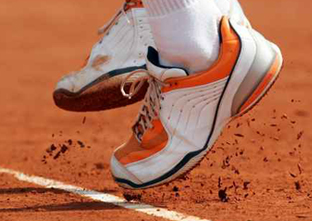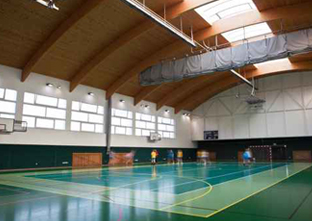
Comfort and protection
Synthetic materials – the real thing !
For a sports player, comfortable clothing is critical, and it must be right for the specific demands of the sport: water penetration resistance for water sports, aerodynamics for running and cycling ... The clothes have to cling to the body at all times (during muscle work for example) or be “breathable” while keeping the athlete warm. In short, they have to deliver comfort. Which is why sportswear manufacturers are now using only synthetics whose functional properties - like durability, chemical resistance, permeability or impermeability, thermal properties, elasticity, etc. - have made them the “go to” materials for so-called technical clothing design.

High-tech for all
 If there is one area where the Sunday sports player can rival the professional athlete, it’s in the look! You can now take to the tennis court or football pitch in footwear as worn by your heroes. New materials like elastane, polyester and polyamide came quickly into widespread use in sportswear through the economies of scale delivered by mass production. Polypropylene clothing that stays dry in contact with skin even during exertion is in a sportswear shop near you now!.
If there is one area where the Sunday sports player can rival the professional athlete, it’s in the look! You can now take to the tennis court or football pitch in footwear as worn by your heroes. New materials like elastane, polyester and polyamide came quickly into widespread use in sportswear through the economies of scale delivered by mass production. Polypropylene clothing that stays dry in contact with skin even during exertion is in a sportswear shop near you now!.
Nanotechnology in your clothes
 The revolution in technical synthetic fibres is just beginning, as clothing is set to become using built-in microsensors. Manufacturers have been talking up the possibility for years. Predicting, for example, that next-generation clothing will be able to automatically deliver a dose of sugar through skin pores to prevent hypoglycaemia is not in the realms of science fiction.
The revolution in technical synthetic fibres is just beginning, as clothing is set to become using built-in microsensors. Manufacturers have been talking up the possibility for years. Predicting, for example, that next-generation clothing will be able to automatically deliver a dose of sugar through skin pores to prevent hypoglycaemia is not in the realms of science fiction.
What sort of reception will these smart clothes get from official sports bodies? It is hard to say, because performance is not the be all-end all for them. Boosting athletes’ performance is all well and good, but not at the expense of entertainment. Hence the 2009 ban on the revolutionary polyurethane wetsuits which mitigated drag effects to allow swimmers to go faster.
Footwear: sole music !
Take a close look at a modern sports shoe sole and stand amazed at how much technology it packs in! They are all now designed to meet the specific needs of athletes: shock absorption for runners, rigidity, for footballers, flexibility for cyclists, etc. These soles now made with PVC, polyurethane foam, butyl rubber, polyester, silicone, etc., are impact resistant and provide optimum distribution of foot pressure while helping to control torsion.

On track for comfort
 Le But comfort is not just about what you wear. In many sports, it’s also about what you play on. Ask your knees about the difference in playing basketball on a very hard or soft surface! For manufacturers, it’s about squaring the circle: the floor has to be soft enough to be comfortable for the players (for joints, but also to avoid fall burns) but with enough rigidity to allow good ball bounce in a gym, for instance. Once again, it was plastics to the rescue. And while manufacturers are tight-lipped about their secrets, what we can say is that these perfect floor coverings are mostly made of PVC - or polyurethane for more elite-level surfaces - polyurethane foam and granulated rubber.
Le But comfort is not just about what you wear. In many sports, it’s also about what you play on. Ask your knees about the difference in playing basketball on a very hard or soft surface! For manufacturers, it’s about squaring the circle: the floor has to be soft enough to be comfortable for the players (for joints, but also to avoid fall burns) but with enough rigidity to allow good ball bounce in a gym, for instance. Once again, it was plastics to the rescue. And while manufacturers are tight-lipped about their secrets, what we can say is that these perfect floor coverings are mostly made of PVC - or polyurethane for more elite-level surfaces - polyurethane foam and granulated rubber.
 The same innovations are also found on outdoor athletics tracks. Gone are the cinder and clay tracks of the 1960s! Today’s tracks are made of polyurethane-bonded rubber granules, making them resistant to moisture, ultraviolet rays, and even extreme temperature differences, and usable all year round. And they come in a variety of colour options.
The same innovations are also found on outdoor athletics tracks. Gone are the cinder and clay tracks of the 1960s! Today’s tracks are made of polyurethane-bonded rubber granules, making them resistant to moisture, ultraviolet rays, and even extreme temperature differences, and usable all year round. And they come in a variety of colour options.
A plastic guardian angel
Polymers and other composites have improved athletes’ performances and comfort in no small measure. But higher performance also means a risk of more serious fall and impact injuries. And what first springs to mind is obviously headgear. Helmets are now compulsory in competitive cycling. They are constituted of two main components: the shell (carbon fibre, glass fibre or polycarbonate), and a shock-absorbing protective polystyrene foam liner. Again, manufacturing prowess has been used to design aerodynamic helmets with good ventilation.

Protected from head to toe
 Protective equipment is not just for cyclists, though; it is also needed for combat sports, horseback riding, fencing, etc. Those who practice all these sports also have to protect themselves from untoward falls and knocks ... And for them, plastics, polymers and composites have become absolute musts. Taking a cue from the PVC foam lined protective vests for horse riders, these new materials provide maximum protection, like knee and elbow pads, protective cups, swimming goggles, mouth guards and shin guards, boxing gloves ... All these accessories have become standard for all amateur and professional sports players. And the reason for their great success is surely because of the effective protection they give, but also because mass manufacturing techniques have priced them within everyone’s pocket.
Protective equipment is not just for cyclists, though; it is also needed for combat sports, horseback riding, fencing, etc. Those who practice all these sports also have to protect themselves from untoward falls and knocks ... And for them, plastics, polymers and composites have become absolute musts. Taking a cue from the PVC foam lined protective vests for horse riders, these new materials provide maximum protection, like knee and elbow pads, protective cups, swimming goggles, mouth guards and shin guards, boxing gloves ... All these accessories have become standard for all amateur and professional sports players. And the reason for their great success is surely because of the effective protection they give, but also because mass manufacturing techniques have priced them within everyone’s pocket.





